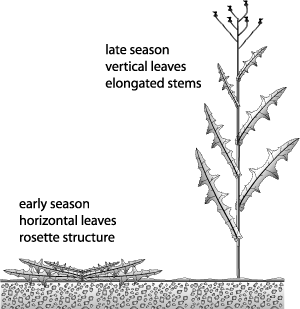Page 160
|
The prickly lettuce (Lactuca serriola) is a common annual weed throughout most of the United States. This plant is unusual in that it has two leaf types shown below. Early in its life cyle (April-May), the plant has rossette leaves that are horizontal in their orientation. Just before flowering (June-July), the meristem bolts and the new leaves are all vertically oriented with the leaf surfaces facing in an east-west direction.
This past year several students in my class became involved in a project measuring aspects of the leaf energy balance and water loss for this plant. The students measured the leaf conductances to water vapor at midday (between 11:45 am and 12:15 pm) on clear days. To my surprise, the measured leaf conductance values were identical for both horizontal leaves early in their life cycle and even later in vertical leaves just before flowering. Well, this does intrigue me. I have heard that this change in leaf orientation during development has an adaptive value. Well, it is indeed now clear to me why this change in orientation is useful in extending the plant's activity longer into the summer drought. This year we conducted an experiment in which we modified leaf orientation and then followed water loss, growth, and reproduction by the plant. A detailed description of the methods we used is presented on the following page (page 161). The results of our experiments are presented on the pages following the methods description (page 162). |
